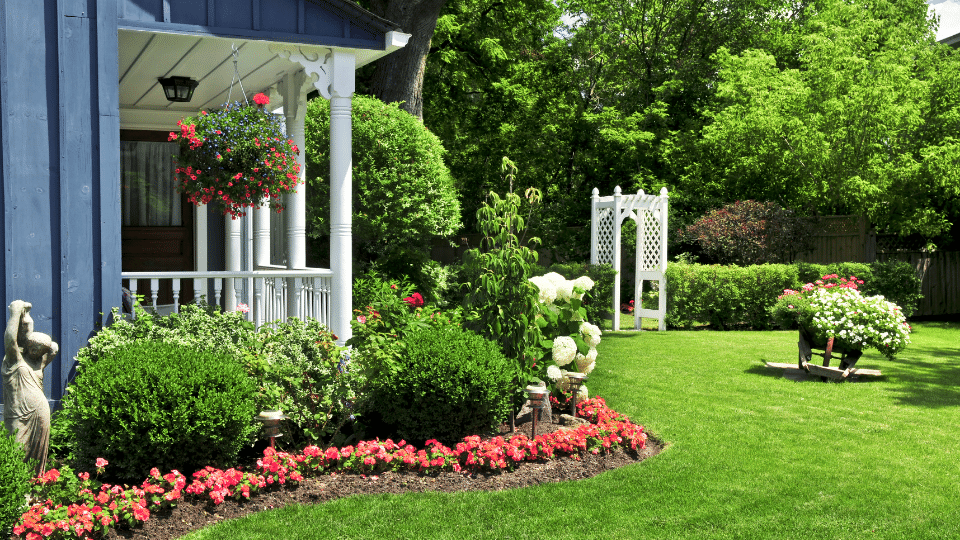The Ultimate Guide to Landscape Maintenance and Yard Work: Transform Your Outdoor Space

Whether you're a homeowner looking to spruce up your property or a renter aiming to keep your yard in top shape, landscape maintenance and yard work are essential for creating a beautiful and functional outdoor space. Searching for "landscape maintenance near me" or "landscaping yard work" often leads to a mix of professional services and DIY tips. In this comprehensive guide, we'll explore everything you need to know about maintaining your landscape, from basic yard work to advanced landscaping techniques, seasonal care, and when to call in the pros. Let’s dig in!
Related: The Ultimate Guide to Patio Awnings with Waterproof Fabric
What is Landscape Maintenance?
Landscape maintenance involves the regular care and upkeep of outdoor spaces, including lawns, gardens, trees, shrubs, and hardscapes like patios or walkways. It’s about keeping your yard healthy, visually appealing, and safe. Unlike one-time landscaping projects (like installing a new garden bed or patio), maintenance focuses on ongoing tasks to preserve and enhance your outdoor environment.
Yard work, a subset of landscape maintenance, typically includes routine tasks like mowing, weeding, raking, and trimming. While yard work is often DIY-friendly, comprehensive landscape maintenance may require specialized skills or equipment, especially for larger properties or complex designs.
Why Landscape Maintenance Matters
A well-maintained landscape offers numerous benefits:
-
Curb Appeal: A tidy yard boosts your home’s aesthetic and property value. Studies show that good landscaping can increase home value by up to 12%.
-
Environmental Benefits: Healthy lawns and plants improve air quality, reduce erosion, and support local wildlife.
-
Personal Enjoyment: A beautiful yard is a space for relaxation, entertaining, or family activities.
-
Preventative Care: Regular maintenance prevents issues like overgrown trees, pest infestations, or lawn diseases, saving you costly repairs.
Neglecting maintenance, on the other hand, can lead to an unkempt appearance, plant loss, or even structural damage (e.g., tree roots disrupting pavement).
Essential Landscape Maintenance Tasks
Let’s break down the core tasks involved in landscape maintenance and yard work. These can be done by homeowners or outsourced to professionals depending on your time, skills, and budget.
1. Lawn Care
A lush, green lawn is the backbone of many landscapes. Key lawn care tasks include:
-
Mowing: Mow regularly (weekly during growing seasons) to keep grass at an optimal height (typically 2.5–3.5 inches for most grass types). Use sharp blades to avoid tearing grass, which can invite disease.
-
Watering: Water deeply but infrequently (about 1 inch per week, including rainfall) to encourage deep roots. Early morning is the best time to water to reduce evaporation and fungal growth.
-
Fertilizing: Apply fertilizer 2–4 times per year, depending on your grass type and climate. Use a slow-release formula to avoid burning the lawn.
-
Aerating: Aerate compacted soil annually to improve air, water, and nutrient flow to grass roots.
-
Weed Control: Pull weeds by hand or use targeted herbicides. Pre-emergent herbicides can prevent weeds before they sprout.
2. Garden Bed Maintenance
Flower beds, vegetable gardens, and shrub borders add color and texture to your yard. Maintenance tasks include:
-
Weeding: Remove weeds weekly to prevent them from competing with plants for nutrients.
-
Mulching: Apply 2–3 inches of organic mulch (e.g., bark, wood chips) annually to retain moisture, suppress weeds, and regulate soil temperature.
-
Pruning: Trim dead or overgrown branches from shrubs and perennials to promote healthy growth and maintain shape.
-
Deadheading: Remove spent flowers from annuals and perennials to encourage more blooms.
-
Soil Care: Test soil every 2–3 years to check pH and nutrient levels. Amend with compost or fertilizers as needed.
3. Tree and Shrub Care
Trees and shrubs are long-term investments that require periodic attention:
-
Pruning: Prune trees and shrubs during their dormant season (late winter or early spring) to remove dead, damaged, or crossing branches. Avoid heavy pruning in summer, which can stress plants.
-
Watering: Young trees need consistent watering (1–2 inches per week) for the first 1–2 years. Mature trees usually rely on rainfall unless there’s a drought.
-
Pest and Disease Monitoring: Inspect for signs of pests (e.g., aphids, scale) or diseases (e.g., leaf spots, powdery mildew). Treat promptly with organic or chemical solutions.
-
Staking: Support young trees with stakes to prevent wind damage, but remove stakes after 1–2 years to avoid girdling.
4. Hardscape Maintenance
Patios, walkways, and retaining walls need care to stay functional and attractive:
-
Cleaning: Pressure-wash or scrub surfaces annually to remove dirt, moss, or algae.
-
Weed Control: Remove weeds from cracks or joints. Use polymeric sand or sealants to prevent future weed growth.
-
Repairs: Fix cracks, loose stones, or shifting pavers promptly to prevent tripping hazards or further damage.
5. Seasonal Cleanups
Each season brings unique maintenance needs:
-
Spring: Rake leaves, aerate lawns, prune shrubs, and plant annuals.
-
Summer: Mow regularly, water consistently, and monitor for pests.
-
Fall: Rake leaves, fertilize lawns, plant bulbs, and cut back perennials.
-
Winter: Protect plants with burlap or mulch, clear snow from walkways, and avoid walking on frozen grass.
DIY vs. Professional Landscape Maintenance
Deciding whether to tackle yard work yourself or hire a professional depends on several factors:
DIY Landscape Maintenance
-
Pros: Cost-effective, satisfying, and allows full control over your yard.
-
Cons: Time-consuming, requires tools and knowledge, and may not yield professional results for complex tasks.
-
Best For: Small yards, routine tasks (mowing, weeding), or passionate gardeners.
Tips for DIY Success:
-
Invest in quality tools (e.g., a reliable mower, pruning shears, rake).
-
Learn about your local climate and plant needs (e.g., USDA Hardiness Zone).
-
Start small to avoid burnout—focus on one area at a time.
Hiring Professionals
-
Pros: Saves time, expert results, access to specialized equipment, and ongoing maintenance plans.
-
Cons: More expensive, less personal involvement.
-
Best For: Large properties, complex landscapes, or busy homeowners.
How to Find Reliable Services:
-
Search “landscape maintenance near me” on Google or platforms like Yelp to find local providers.
-
Check reviews, ask for references, and verify licensing/insurance.
-
Request a detailed quote outlining services (e.g., mowing, pruning, cleanups).
-
Look for companies offering customized plans to fit your budget and needs.
Sustainable Landscape Maintenance Practices
Eco-friendly landscaping is gaining popularity as homeowners seek to reduce their environmental impact. Here are some sustainable practices:
-
Xeriscaping: Use drought-tolerant plants (e.g., succulents, native grasses) to reduce water use.
-
Native Plants: Choose plants native to your region, which require less water, fertilizer, and pest control.
-
Composting: Turn lawn clippings, leaves, and kitchen scraps into nutrient-rich compost for your garden.
-
Organic Pest Control: Use neem oil, insecticidal soap, or beneficial insects (e.g., ladybugs) instead of harsh chemicals.
-
Rainwater Harvesting: Install rain barrels to collect runoff for irrigation.
-
Electric Tools: Switch to battery-powered or electric mowers and trimmers to reduce emissions.
These practices not only save resources but also create a healthier ecosystem in your yard.
Common Landscape Maintenance Mistakes to Avoid
Even seasoned gardeners make mistakes. Here are pitfalls to watch out for:
-
Overwatering: Too much water can drown roots or promote fungal diseases. Use a rain gauge or soil moisture meter to guide watering.
-
Improper Pruning: Cutting too much or at the wrong time can weaken plants. Research pruning techniques for each species.
-
Ignoring Soil Health: Poor soil leads to weak plants. Test and amend soil regularly.
-
Planting Invasives: Some plants (e.g., English ivy, bamboo) can overtake your yard or harm local ecosystems. Check with your local extension service before planting.
-
Neglecting Maintenance Schedules: Skipping tasks like aeration or fertilization can lead to long-term issues.
Tools and Equipment for Landscape Maintenance
Having the right tools makes yard work easier and more efficient. Essential tools include:
-
Lawn Mower: Gas, electric, or push, depending on yard size.
-
String Trimmer: For edging and hard-to-reach areas.
-
Pruning Shears: For shrubs, roses, and small branches.
-
Rake: For leaves and debris.
-
Shovel and Spade: For planting and digging.
-
Wheelbarrow: For moving mulch, soil, or debris.
-
Hose or Irrigation System: For consistent watering.
For larger yards or frequent use, consider investing in a leaf blower, hedge trimmer, or aerator. Rent specialized equipment (e.g., stump grinders) for one-off tasks.
Related: Scoring a Great Deal on Used Zero Turn Mowers: Your Guide to Leftover and Husqvarna Finds
How Much Will It Cost?
Costs vary depending on whether you DIY or hire professionals:
-
DIY Costs: Tools ($100–$1,000 initially), supplies (mulch, fertilizer, plants: $50–$500/year), and water/electricity for equipment.
-
Professional Costs: Basic lawn care ($30–$100 per visit), full maintenance ($100–$500/month), or one-time cleanups ($200–$1,000). Prices depend on yard size, services, and location.
To save money, combine DIY for simple tasks (e.g., mowing) with professional help for complex ones (e.g., tree pruning).
Final Thoughts: Transform Your Yard Today
Landscape maintenance and yard work are investments in your home’s beauty, value, and functionality. Whether you’re mowing your lawn, planting a garden, or hiring a local service for “landscape maintenance near me,” regular care ensures your outdoor space thrives year-round. Start with small, manageable tasks, adopt sustainable practices, and don’t hesitate to call professionals when needed. With the right approach, your yard can become a stunning, low-maintenance oasis.
Ready to get started? Grab your tools, plan your maintenance schedule, or contact a local landscaper to bring your vision to life. Your dream yard is just a few steps away!
ADVERTISEMENT





